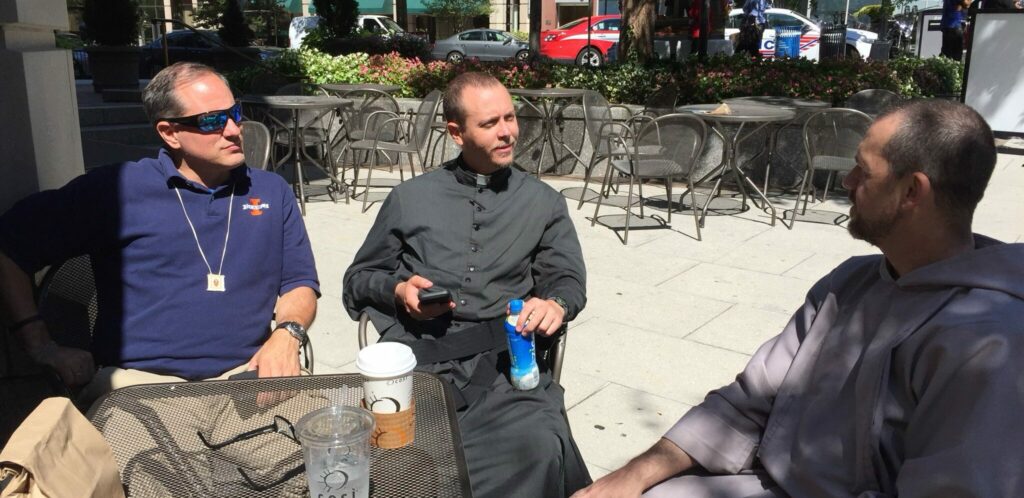Most Catholics are called to be married folks or priests or nuns/sisters. But there are some other unusual vocations in the Church that good Catholics are talking about more and more. An infrequent but valid vocation is a single-celibate or consecrated-virgin living in the world. It is most certainly a real vocation if one takes private promises (or vows) through a permanent (or temporary) spiritual director (or mentor.)
Sometimes these lay brothers or consecrated virgins living in the world refrain from wearing religious habits, but live in community. Sometimes, they refrain from both religious habits and communities. These people choose to live alone, or perhaps have no option based on past wounds. Again, this is a very pleasing vocation to God, provided that the single-celibate make private promises to God through a priest or mentor. As we will see later, this doesn’t have to be through a heavy-handed spiritual director.
Before going further, I want to review the chronology of discernment that I put in an article last week on Vocation Directors. In that, I wrote how every unmarried man or woman should approach discernment of his or her future. The traditional order of operations in discernment is figuring-out: 1) continence vs. marriage and then 2) one congregation vs. another congregation and finally 3) brotherhood vs. priesthood. And the last of the three was mostly done by the man’s congregation. (That order of discernment is not my opinion.) That’s how it worked from 33AD through the 1970s.
Now let’s imagine a young person comes to the conclusion he has been given the gift of celibacy/continence, but not religious life (as St. Benedict Labre discovered the hard way.) He has no other option but to be a single-celibate without pursuit of the Holy Priesthood. Yet some traditional priests today scoff at the notion of single-celibacy. Why? Because they erroneously believe that every Catholic should be a priest, monk, nun or married person.
Such ignorant priests are living in a time-warp to the 1950s without knowledge of the great many single-celibates who chose not to live in community, or were unable to live in community. This list includes many canonized saints like St. Mary of Egypt, St. Catherine of Siena, St. Benedict Labre, St. Philip Neri (for some of his life) and even modern holy people like Bl. Pier Giorgio Frassati. (Frassati is a unique case since his father stopped him from marrying “down” and also because he died young.)
However, the traditional priests who discourage young people from being single-celibates or consecrated-virgins are right to be cautious that it is a very dangerous vocation to live alone.
Nevertheless, besides the great many saints who never fit into community (like the above mentioned St. Benedict Labre) we also have to realize we live in the 21st century, which itself has unprecedented dangers in Church history. For example, we have recently come across horrible documents like Cor Orans which claims it is a document on “instruction of women’s contemplative life.” In reality, Cor Orans is destroying women’s contemplative life. That document (and the Marxists behind it) wants all young women to be old bus-nuns traveling around for social-justice. Like Satan effecting the French Revolution and Bolshevik Revolution, the enemy of salvation of souls knows that the first thing that has to be eradicated is contemplative congregations of men and women.
Thankfully, we still have a few good traditional female congregations today. I have encouraged young women to join canonically-regular orders like the Benedictines of Gower (associated with the FSSP) and I have encouraged young women to canonically-irregular congregations like the Consoling Sisters of the Sacred Heart (associated with the SSPX.) Congregations that are canonically-irregular have chosen to be invincible from apostate Rome. However, the groups of canonically-regular female congregations can be modified or eradicated by documents like Cor Orans, and those who execute them. There are very holy women in both types of orders (both those serviced by SSPX and those by FSSP) so I’m not taking a side. I’m just saying that their relationship with the Vatican may play into their continuance in the future.
In any case, canonically-regular traditional priests need to stop pretending like it’s the 1950s when there were several hundred solid TLM orders for both men and women to join. We just don’t live in times like that. In wacky times of Church crisis (like ours) we need to be open to extraordinary vocations (like single-celibate living in the world.) I admit that it’s much safer to get to heaven in a monastery via celibacy or even in a family via marriage. I admit that with all of my heart. But as most solid traditional orders (of both men and women) are getting attacked by the Vatican, people may have to get creative in vocations that are both creative and pleasing to God. By “creative” I mean single-celibacy without a congregation maintaining formal canonical status in a diocese may be the way to go for a select few.
As I wrote here, I am not a fan of heavy-handed traditional spiritual directors. However, I have agreed to witness private vows for a single-celibate woman without being her spiritual director. (She has now taken promises to God twice through me and she is doing very well in her vocation.) I discouraged this woman (in a different State from CO) from involving her local bishop, though I never specifically told her to hide her consecration from him. Why? Because while it might look fancy to walk around the diocese with an official habit and diocesan approval, the responsibilities leveled by modernists always outweigh its rights, especially in such times when orthodoxy is punished by liberal inquisitions.
To prevent manipulation by the hierarchy, I suggest the spiritual director guide the potential single-celibate into promises, not vows. To prevent discouragement, I also suggest these promises be temporary (eg yearly) not permanent. I also suggest one takes promises of only continence and simplicity (not the full-blown promises in religion of poverty, chastity and obedience.) Why? Because it’s a mortal sin to break a vow. Thus, there is no need to put extra weight on yourself when you don’t have a community to keep you accountable. In summary, just promise continence and financial simplicity in yearly-frequency through a non-heavy-handed spiritual director to God. That way, your life of freedom in Christ has flexibility. Flexibility on a schedule may not be good in a monastery, but it is often required while living in the world.
That particular consecrated-soul mentioned two paragraphs above has never struggled with same-sex attraction, but those who have carried such heavy crosses may find living as consecrated-virgins in the world is much healthier than living in community where temptation abounds. (This is further reason why I don’t understand why so many Catholics today believe gay men have only the two options of priesthood or impurity.) There are many options besides parish priesthood and religious monasteries as you look through 2,000 years of Church history.
Finally, I think we can compare the last age of the Church to the first age of the Church insofar as we decipher a remnant of solid Christians living among pagans. Just as the early Church produced single-celibates living in Rome and Constantinople (many of whom had no canonical status, yet became canonized martyrs) so also in the last age of the Church we may have holy people who have no special canonical status (or habit) and yet become saints and martyrs. Traditional priests need to encourage (not mock) these people. We may see more and more young people (or widows) who desire to cling to the Lord Jesus with an undivided heart, yet refrain from communal living in a congregation. It’s certainly not the ideal to live without a community, but it’s better than joining a traditional order that gets shut down in the next few years.

Will Goodman (left) is a single-celibate in the pro-life world and he is one of the holiest people I know. I believe he’s currently in prison for his peaceful pro-life work. (Middle is me. Right is Fr. Fidelis CFR. Pic in Wash DC after an arrest and trial.)
Donate to my future hermitage and chapel here.
